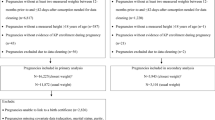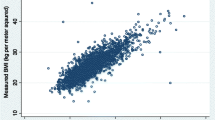Abstract
To investigate the reliability and validity of weight, height, and body mass index (BMI) from birth certificates with directly measured values from the Women, Infants, and Children (WIC) Program. Florida birth certificate data were linked and compared with first trimester WIC data for women with a live birth during the last quarter of calendar year 2005 (n = 23,314 women). Mean differences for weight, height, and BMI were calculated by subtracting birth certificate values from WIC values. Reliability was estimated by Pearson’s correlation. Validity was measured by sensitivity and specificity using WIC data as the reference. Overall mean differences plus or minus standard error (SE) were 1.93 ± 0.04 kg for weight, −1.03 ± 0.03 cm for height, and 1.07 ± 0.02 kg/m2 for BMI. Pearson’s correlation ranged from 0.83 to 0.95, which indicates a strong positive association. Compared with other categories, women in the second weight group (56.7–65.8 kg), the highest height group (≥167.6 cm), or BMI < 18.5 had the greatest mean differences for weight (2.2 ± 0.08 kg), height (−2.4 ± 0.05 cm), and BMI (1.5 ± 0.06), respectively. Mean differences by maternal characteristics were similar, but statistically significant, likely in part from the large sample size. The sensitivity for birth certificate data was 77.3% (±1.42) for underweight (BMI < 18.5) and 76.4% (±0.51) for obesity (BMI ≥ 30). Specificity was 96.8% (±0.12) for underweight and 97.5% (±0.12) for obesity. Birth certificate data had higher underweight prevalence (6 vs. 4%) and lower obesity prevalence (24 vs. 29%), compared with WIC data. Although birth certificate data overestimated underweight and underestimated obesity prevalence, the difference was minimal and has limited impact on the reliability and validity for population-based surveillance and research purposes related to recall or reporting bias.
Similar content being viewed by others
References
Reichman, N. E., & Hade, E. M. (2001). Validation of birth certificate data. A study of women in New Jersey’s HealthStart program. Annals of Epidemiology, 11, 186–193.
Roohan, P. J., Josberger, R. E., Acar, J., Dabir, P., Feder, H. M., & Gagliano, P. J. (2003). Validation of birth certificate data in New York State. Journal of Community Health, 28, 335–346.
Zollinger, T. W., Przybylski, M. J., & Gamache, R. E. (2006). Reliability of Indiana birth certificate data compared to medical records. Annals of Epidemiology, 16, 1–10.
DiGiuseppe, D. L., Aron, D. C., Ranbom, L., Harper, D. L., & Rosenthal, G. E. (2002). Reliability of birth certificate data: A multi-hospital comparison to medical records information. Maternal and Child Health Journal, 6, 169–179.
Northam, S., Polancich, S., & Restrepo, E. (2003). Birth certificate methods in five hospitals. Public Health Nursing, 20, 318–327.
Chu, S. Y., Kim, S. Y., & Bish, C. L. (2009). Prepregnancy obesity prevalence in the United States, 2004–2005. Maternal and Child Health Journal, 13(5), 614–620.
Ramachenderan, J., Bradford, J., & McLean, M. (2008). Maternal obesity and pregnancy complications: A review. Australian and New Zealand Journal of Obstetrics and Gynaecology, 48, 228–235.
Chu, S. Y., Bachman, D. J., Callaghan, W. M., et al. (2008). Association between obesity during pregnancy and increased use of health care. New England Journal of Medicine, 358, 1444–1453.
Morin, K. H., & Reilly, L. (2007). Caring for obese pregnant women. Journal of Obstetric, Gynecologic, and Neonatal Nursing, 36, 482–489.
Thompson, D. R., Clark, C. L., Wood, B., & Zeni, M. B. (2008). Maternal obesity and risk of infant death based on Florida birth records for 2004. Public Health Reports, 123, 487–493.
Kiel, D. W., Dodson, E. A., Artal, R., Boehmer, T. K., & Leet, T. L. (2007). Gestational weight gain and pregnancy outcomes in obese women: How much is enough? Obstetrics and Gynecology, 110, 752–758.
Cedergren, M. I. (2007). Optimal gestational weight gain for body mass index categories. Obstetrics and Gynecology, 110, 759–764.
Institute of Medicine. (1990). Nutrition during pregnancy: Part I: Weight gain, Part II: Nutrient supplements. Washington DC: National Academies Press.
National Center for Health Statistics. (2003). 2003 revisions of the US standard certificates of live birth and death and the fetal death report [online]. Available at: http://www.cdc.gov/nchs/vital_certs_rev.htm. Accessed 6 October 2009.
Spencer, E. A., Appleby, P. N., Davey, G. K., & Key, T. J. (2002). Validity of self-reported height and weight in 4808 EPICOxford participants. Public Health Nutrition, 5, 561–565.
Kuczmarski, M. F., Kuczmarski, R. J., & Najjar, M. (2001). Effects of age on validity of self-reported height, weight, and body mass index: Findings from the Third National Health and Nutrition Examination Survey, 1988–1994. Journal of the American Dietetic Association, 101, 28–34.
Nawaz, H., Chan, W., Abdulrahman, M., Larson, D., & Katz, D. L. (2001). Self-reported weight and height implications for obesity research. American Journal of Preventive Medicine, 20, 294–298.
Villanueva E. V. (2001). The validity of self-reported weight in US adults: A population based cross-sectional study. BMC Public Health 1:11. Available at: http://www.pubmedcentral.nih.gov/picrender.fcgi?artid=59896&blobtype=pdf. Accessed October 6, 2009.
Niedhammer, I., Bugel, I., Bonenfant, S., Goldberg, M., & Leclerc, A. (2000). Validity of self-reported weight and height in the French GAZEL cohort. International Journal of Obesity and Related Metabolic Disorders, 24, 1111–1118.
Brunnerhuber, L. R. (2007). Validity of self-reported height and weight in women of reproductive age. Maternal and Child Health Journal, 11, 137–144.
Florida Department of Health. (2008). State of Florida vital records. Available at: http://www.doh.state.fl.us/planning_eval/Vital_Statistics/index.html. Accessed October 6, 2009.
Florida Department of Health. (2009). Office of vital statistics. Vital records registration handbook November 2008 Revision. Available at: http://www.doh.state.fl.us/Planning_eval/Vital_Statistics/November_2008_Reg_Handbook.pdf. Accessed October 6, 2009.
Florida Department of Health. (2009). Bureau of WIC and nutrition. Florida WIC Good Nutrition for Women, Infants & Children. http://floridawic.org/pages/wic.htm. Accessed October 9, 2009.
Neufeld, L. M., Haas, J. D., Grajéda, R., & Martorell, R. (2004). Changes in maternal weight from the first to second trimester of pregnancy are associated with fetal growth and infant length at birth. American Journal of Clinical Nutrition, 79, 646–652.
Larciprete, G., Valensise, H., Vasapollo, B., et al. (2003). Body composition during normal pregnancy: Reference ranges. Acta Diabetologica, 40(Suppl 1), S225–S232.
National Heart, Lung, and Blood Institute. (1998). Clinical guidelines on the identification, evaluation, and treatment of overweight and obesity in adults: The evidence report. Rockville, MD: National Institutes of Health. Available at: http://www.nhlbi.nih.gov/guidelines/obesity/ob_gdlns.pdf. Accessed October 6, 2009.
Nyholm, M., Gullberg, B., Merlo, J., Lundqvist-Persson, C., Råstam, L., & Lindblad, U. (2007). The validity of obesity based on self-reported weight and height: Implications for population studies. Obesity, 15, 197–208.
Craig, B. M., & Adams, A. K. (2009). Accuracy of body mass index categories based on self-reported height and weight among women in the United States. Maternal and Child Health Journal, 13(4), 489–496.
John, U., Hanke, M., Grothues, J., & Thyrian, J. R. (2006). Validity of overweight and obesity in a nation based on self-report versus measurement device data. European Journal of Clinical Nutrition, 60, 372–377.
Dietz, P. M., Adams, M. M., Spitz, A. M., Morris, L., & Johnson, C. H. (1999). Live births resulting from unintended pregnancies: Is there variation among states? The PRAMS Working Group. Family Planning Perspectives, 31(3), 132–136.
Author information
Authors and Affiliations
Corresponding author
Additional information
This work was done while the first author (SP) was in the EIS program, CDD/OWCD/OD, Centers for Disease Control and Prevention.
Disclaimer: The findings and conclusions in this report are those of the author(s) and do not necessarily represent the official position of the Centers for Disease Control and Prevention.
Rights and permissions
About this article
Cite this article
Park, S., Sappenfield, W.M., Bish, C. et al. Reliability and Validity of Birth Certificate Prepregnancy Weight and Height Among Women Enrolled in Prenatal WIC Program: Florida, 2005. Matern Child Health J 15, 851–859 (2011). https://doi.org/10.1007/s10995-009-0544-4
Published:
Issue Date:
DOI: https://doi.org/10.1007/s10995-009-0544-4




